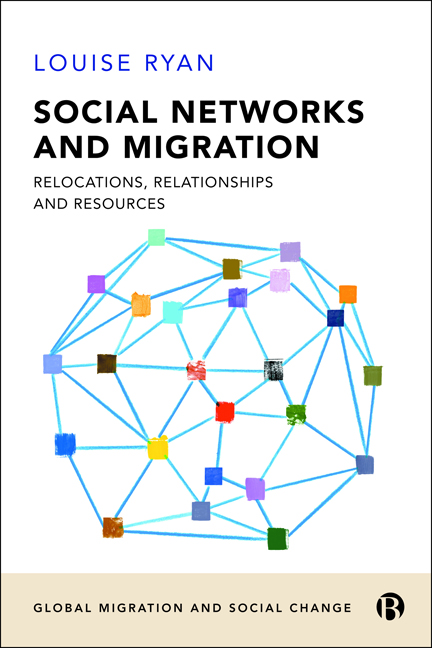Book contents
- Frontmatter
- Contents
- List of Figures
- About the Author
- Acknowledgements
- 1 Introduction: Embarking on a Book about Networks
- 2 Conceptualising Migrant Networks: Advancing the Field of Qualitative Social Network Analysis
- 3 Researching Migration and Networks: Empirical and Methodological Innovations
- 4 Social Networks and Stories of Arrival
- 5 Employment, Deskilling and Reskilling: Revisiting Strong and Weak Ties
- 6 Evolving Networks in Place over Time: A Life Course Lens
- 7 Transnational Ties: Narrating Relationality, Resources and Dynamics over Time
- 8 Conclusion: Thoughts and Future Directions
- Appendix
- Notes
- References
- Index
7 - Transnational Ties: Narrating Relationality, Resources and Dynamics over Time
Published online by Cambridge University Press: 18 January 2024
- Frontmatter
- Contents
- List of Figures
- About the Author
- Acknowledgements
- 1 Introduction: Embarking on a Book about Networks
- 2 Conceptualising Migrant Networks: Advancing the Field of Qualitative Social Network Analysis
- 3 Researching Migration and Networks: Empirical and Methodological Innovations
- 4 Social Networks and Stories of Arrival
- 5 Employment, Deskilling and Reskilling: Revisiting Strong and Weak Ties
- 6 Evolving Networks in Place over Time: A Life Course Lens
- 7 Transnational Ties: Narrating Relationality, Resources and Dynamics over Time
- 8 Conclusion: Thoughts and Future Directions
- Appendix
- Notes
- References
- Index
Summary
Introduction
Ever since the 1990s’ ‘transnational turn’ in migration studies (Schiller et al, 1992), there has been a huge body of research on the salience of migrants’ identification and connection with their origin countries (for example, Faist and Ozveren, 2004; Parreñas, 2005; Goulbourne et al, 2010; Bryceson and Vuorela, 2020).
However, as Dahinden notes, ‘the initial euphoria’ about transnationalism ‘has been replaced by a certain sobriety’ (2005: 192): ‘While the transnational perspective brings interesting insights to the study of migration processes’, she cautions that ‘transnational ties and social relations must not be presumed but rather carefully analysed’ (Dahinden, 2005: 191). The fact that migrants have transnational connections tells us very little about what is actually going on within those relationships (Ryan and D’Angelo, 2018; Nowicka, 2020). SNA can reveal much about the make-up, meaning and dynamism of transnational ties (Bilecen et al, 2018; Lubbers, et al, 2021). The first aim of this chapter is to apply the framework of telling network stories in order to explore the meaning of long-distance relationships and the resources flowing therein.
Of course, migrants’ cross-border communications are not new. Historians have studied the importance of long-distance correspondence, especially letters, over the centuries (Skrbiš, 2008). As Nancy Foner (1997) notes, many transnational practices hailed as ‘new’ actually have a long history. Nonetheless, a key difference nowadays is the extent to which technology can create a sense of co-presence in real time (Madianou and Miller, 2013). So-called ‘transconnectivity’ can mean that migrants feel part of the everyday lives of relatives back home (King-O’Riain, 2015). However, such technological connections are not without limits (von Koppenfels et al, 2015) and rarely replace the need for proximate physical contact, especially hands-on care with children (Ryan, 2007a) or elderly relatives (Wilding and Baldassar, 2009). Hence, the chapter's second aim is to consider how migrants connect transnationally and the changing patterns of long-distance communication over generations.
Through network stories, including visualisation techniques, and longitudinal methods, I also seek to understand relational change over time (Ryan and D’Angelo, 2018). Migrants’ continued embedding in transnational relationships cannot be taken for granted (Ryan et al, 2021). Despite communication technologies, ties may weaken through prolonged separation. Hence, the chapter's third aim is to analyse how transnational ties ebb and flow, with changing needs, through different life course stages (Ryan, 2018).
- Type
- Chapter
- Information
- Social Networks and MigrationRelocations, Relationships and Resources, pp. 128 - 151Publisher: Bristol University PressPrint publication year: 2023

